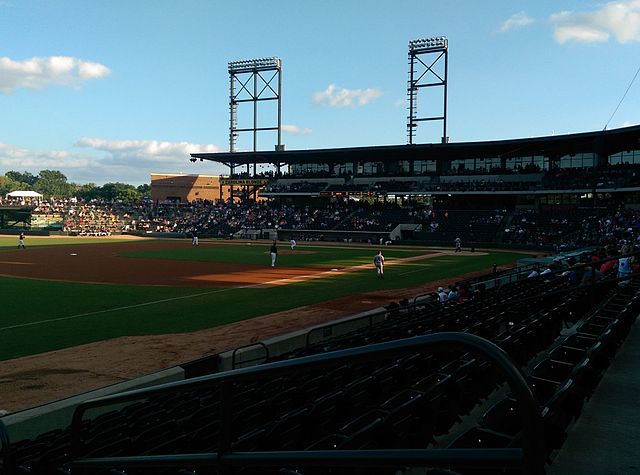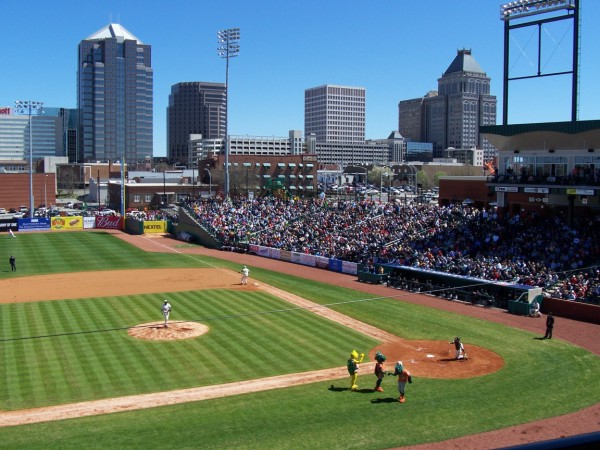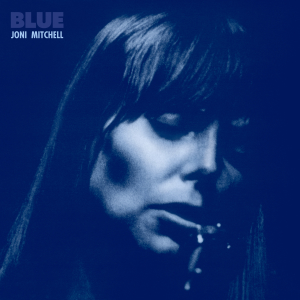Our 2022 baseball quest has reached its end. The Nashville Sounds cruised to an easy 9-1 win over the Charlotte Knights, Friday, September 9. I guess a quest is not supposed to end with the Knights losing, but I am celebrating nonetheless. Whew!
If it isn't obvious, Angela and I chose which games to attend based on scheduling needs, not baseball criteria. The outcome of this game might have been expected, considering Nashville is in first place in their division of the International League, and Charlotte is in last place in its division.
This year's Knights team is Class AAA's Island of Misfit Toys. Their best player is a 30-year-old, short, stocky guy churning around center field. Their right fielder looks like Adonis but strikes out too much and doesn't hustle. Their corpulent first baseman is a failed catcher. The best athletes are not good enough players, and vice versa. Maybe the White Sox will deal them a better hand next season.
What can I say about the city of Charlotte that it hasn't already said about itself? It is North Carolina's largest city, and it has the traffic and the steel-and-glass towers to go with that status. The place has grown and changed determinedly in my lifetime. In the 1980s and 90s, Charlotte elbowed its way from being a regional banking center to a national one. In the same time frame, it became a major league pro sports city, landing teams in the NBA and NFL. (Raleigh acquired an NHL hockey team, but it's a consolation prize.)
The rest of the state has a complex about Charlotte: the eldest, most successful sibling that the others have tepidly loyal but slightly resentful feelings toward. A series of politicians has thought that being mayor of Charlotte would be a springboard to higher political office, like Governor or Senator. Most of them have been disappointed. Rural voters don't like city pols in general, and voters in the other North Carolina cities just don't especially like Charlotte.
Despite its strong minor league history, North Carolina has never had an MLB team. It took some doing just to get Charlotte elevated to Class AAA status in 1993. But Charlotte has had a minor-league team almost continuously since 1901.
The team was called the Hornets for many years. There is a disputed story about a 1775 Mecklenburg Declaration of Independence. Whatever the authenticity of this document, it is true that a British official referred to Mecklenburg County as a "hornet's nest" of rebellious sentiment. Some Charlotte people take a lot of pride in this history, and adopted the Hornets nickname for their ball team. Of course, the Charlotte NBA franchise has now claimed that nickname.
My circa-1985 memory is that Charlotte's ballpark was tired and shabby. Truist Stadium, opened in 2014, is pristine; Angela considers it the nicest ballpark we've visited, hands-down. As McCormick Field is surrounded by trees, Truist is surrounded by skyscrapers. It's a nice view from inside.
 |
| Photo by JBJ |
This was a special night at the ballpark for the Catholic Diocese of Charlotte. A nun threw out the first pitch; a chorus of seminarians sang "Take Me Out to the Ball Game;" the bishop said a few words via the JumboTron. All unexpected, but nice. Ballpark foods consumed: Philly cheese steak (I had it in sandwich form, Angela in nachos form) that was sinfully good. Beer enjoyed: a Hop Drop 'N Roll IPA from NoDa Brewing Company in Charlotte.
Charlotte grew up with the Southern textile manufacturing industry after the Civil War. As a banking and railroad hub, it was first among equals relative to Gastonia, Concord, Albemarle, and others. At heart, though, in its earnest boosterism, Charlotte is a big small town, the biggest mill town of them all.
- Huntersville native Hoyt Wilhelm (1922-2002) broke into pro ball in 1942 with the Mooresville Moors, just a few miles from home. Class D ball, unaffiliated, the lowest rung of the ladder. He entered WW2 military service for three years, then spent two more seasons in Mooresville. Big-league teams consistently doubted him: he was a knuckleball pitcher, which was unfashionable, and he got a late start due to the war. Wilhelm was a surprise success as a 29-year-old rookie reliever with the New York Giants. He bounced from team to team. But he lasted until age 49 and was an All-Star as late as age 47. He set an MLB record by pitching in 1,070 games. Wilhelm entered the Baseball Hall of Fame in 1985, capping a remarkable, sprawling career.
- Sonny Dixon (1924-2011) has a lot in common with Hoyt Wilhelm: He broke in with his hometown team, the Charlotte Hornets, and he was slow to fledge and leave the nest. He was a right-handed pitcher, a rubber-armed innings eater. Like Wilhelm, he spent the years 1943-45 fighting WW2. He rose through the minors slowly. Unlike Wilhelm, he had the bad luck to wind up with weak parent organizations; he broke into the bigs with the Senators and then pitched for the Athletics (Philly and KC). His final MLB stint, three appearances, was with the 1956 Yankees. Dixon pitched for the Hornets again at ages 34-35 before hanging them up. He lived most of his life in the Steele Creek community near Charlotte, and is buried there.
- Minnie Mendoza (b. 1933 or 1934) was born and raised in Cuba, but is an honorary Charlottean thanks to spending 10 seasons with the Charlotte Hornets when they were a Senators/Twins farm team. He was sort of a full-time utility infielder, a Billy Goodman or Tony Taylor type, about the same quality. Why he spent so long at Class AA Charlotte, I don't know--possibly for his coach/mentor qualities. He finally got his cup of coffee in the Show with Minnesota in 1970, when he was 35 (maybe 36) years old.
- Raised in the world of mill-town baseball, Tommy Helms (b. 1941) went on to be the regular second baseman on the 1970 Cincinnati Reds, who won the NL pennant. He was a 9-year MLB regular with the Reds then the Astros. A good glove man, he enabled Pete Rose to switch from 2B to right field. Tommy's nephew Wes Helms is an ex-major league player and formerly managed the Charlotte Knights.
- Dickie Noles (b. 1956) was a journeyman pitcher, a reliever and spot starter. He spent 16 seasons in the pros, pretty evenly divided between the minors and the majors, mostly with the Phillies and Cubs systems. He earned a World Series ring with the 1980 Phillies. Noles and Ray Durham are both alums of Harding High School in Charlotte.
- Ray Durham (b. 1971) came up with the Chicago White Sox and later played with the A's. Giants, and Brewers. He was damn good; I had him on fantasy teams a couple of years. He had some power, stole some bases, and drew walks. He was a plus fielder at second base, at least in his younger years. Durham was named an All-Star twice (1998 and 2000), had six years of over 100 runs scored, and had a long MLB career: 1975 games, 2054 hits.
- Alex Wood (b. 1991) is a lefty power pitcher, currently with the San Francisco Giants. He pitched in three World Series with the Dodgers, winning a ring in 2020. He was an NL All-Star in 2017, amassing a 16-3 won-loss record. He has dealt with injuries off and on since high school, but he is mighty good when healthy.


















